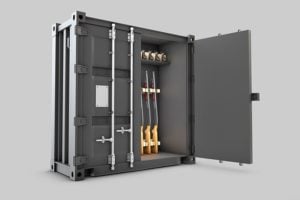Supplies needed:
- Small or medium-sized boxes
- Tape
- Newsprint
- Packing peanuts (optional)
- Bubble wrap (optional)
Instructions:
- Clean, dry, and disassemble your appliance. Make sure that any re-assembly instructions are written and taped to the appliance.
- Prepare the box by taping the bottom. Layer lightly crumpled newsprint or packing peanuts to pad the bottom of the box.
- Place the appliance on a few large sheets of newsprint. Wrap the paper around the entire appliance and seal with tape.
- As appropriate, wrap any removable accessories. If the part is particularly fragile (like a glass microwave tray), use bubble wrap as well as newsprint.
- Place the appliance and accessories in the box. If there is extra room, you can follow the steps above and pack more appliances or fill up extra space with sturdy items like utensils or pans.
- Use crumpled paper or packing peanuts to fill up empty space.
- Tape and label the box.
How to Pack Plates
Plate cell packing kits are provided by moving companies and have simplified packing plates. These kits provide all the supplies and instructions you need for safely packing your plates for the moving process. Plate cell kits are not the only option for packing plates, however. If you do not have these plate cell boxes or don’t want to spend the extra money, you can pack plates safely and securely using basic packing supplies.
Supplies needed:
- Small or medium sized boxes
- Large sheets of bubble wrap
- Newsprint
- Tape
- Optional: packaging peanuts
Instructions:
- Prepare your box by double taping the bottom.
- Line the entire box (bottom and sides) with a large piece of bubble wrap. Make sure there is enough bubble wrap to cover the top when you’re finished packing the box.
- Place a large piece of newsprint on your packing surface.
- Put one plate in the center of the newsprint.
- Place a sheet of bubble wrap (just large enough to cover the surface of the plate) on top of the plate.
- Place another plate on top of the first plate and another sheet of bubble wrap on top of that.
- Repeat once more, so you have three stacked plates.
- Take the corners of the newsprint and wrap the set. Use tape to seal the package.
- Place the wrapped plates on their side in the box. Plates are much stronger on their edges than stacked flat.
- Repeat the steps above, until the box is tightly packed.
- Fill any empty space with crumpled paper or packaging peanuts.
- Tape the box shut. Label the top and side “FRAGILE” and draw a big arrow showing which side is up.
How to Pack Pots & Pans
Supplies needed:
- Large boxes
- Newsprint
- Padding (newsprint, shredded paper, or packaging peanuts)
- Tape
Instructions:
- Prepare a large box by taping the bottom.
- Place a two inch layer of gently crumpled newsprint, shredded paper, or packaging peanuts in the bottom of the box.
- Choose a few pots or pans that can be nested inside each other. For example: a large, medium, and small sized pot.
- Take the largest pot or pan and place a large piece of newsprint over the opening. Nest the smaller sized pot within the first, pushing down the newsprint. Continue to follow the same steps until you’ve nested a few together.
- Place the entire bundle on a large piece of newsprint. Bring the corners of the newsprint up to wrap the entire set and seal it with tape.
- Put the nested pots in the box.
- Continue until you’ve filled the box or it’s reached a reasonable weight. Remember, you can place cooking sheets or cutting boards along the sides or bottom of the box, and cooking utensils (rubber banded together) can fill extra space.
- Tape the box and label it “KITCHEN” along with its contents.
How to Pack Glasses & Stemware
It’s best to pack stemware in cell boxes, sold by supply stores and movers. These boxes protect your glasses, saving you money in replacement costs.
Supplies needed:
- Packing paper
- Tissue paper
- Dish pack / cell boxes
- Packing tape
Instructions:
- For stemware, begin by wrapping the stem with a piece of tissue paper.
- Loosely wrap each glass with a layer of tissue paper and lightly stuff crumpled tissue paper inside the bulb to reinforce the glass’ sides.
- With packing paper, wrap the glasses a second time more tightly.
- Place each glass on its base in separate cells. Lightly pad any empty spots in each cell with tissue paper.
- Once the box is full, cushion the top of the box with tissue paper. Be careful not to overstuff it and add pressure on your glasses and stemware.
- Close the box, and check that nothing rattles inside. If anything is loose, add more padding.
- Tape the packed box closed, label it “FRAGILE” and note which side is up.
How to Pack Wine
If you have to move a wine collection, there are a couple of different options for safely transporting it. First, ask yourself if it is really worth transporting. If your collection is small and easily replaceable, you may consider using it for a going away party and replacing the bottles later on.
If you are sure you want to transport your wine, you will need the following:
- Cell boxes: Cell boxes are specifically designed to transport bottles and can be purchased from a winery, liquor store or moving supply store.
- Newsprint or Bubble Wrap: You can purchase pre-cut sheets of newsprint at a moving store or you can try to find a bargain by purchasing a roll of newsprint at an arts supply store. The bubble wrap can be purchased at big-box stores or at shipping supply vendors.
- Packing Peanuts and Tape: You will want to get a small quantity of packing peanuts or, alternatively, shredded paper. As for tape, any kind will suffice, but packing tape is recommended.
If you are packing opened bottles, make sure they are properly closed and tightened. Begin by placing the bottle diagonally on the corner of a couple of sheets of newsprint or a sheet of bubble wrap. Roll the bottle diagonally on the sheet while folding the excess on the sides as you roll the bottle. When you finish rolling, wrap the bottle with packing tape and secure any loose ends.
Once you have wrapped all of your bottles, place them in the cell box. For extra safety, you should consider reinforcing the cell box by taping an extra piece of cardboard to the bottom. Fill the gaps in the box with packing peanuts or crumpled paper and seal the top with plenty of tape. Clearly label the box as fragile. Temperature Controlled Wine Transport
Although it would be ideal to maintain your wine at 55F, it is not practical for most cases. For a large wine collection, however, consider contacting companies with climate-controlled moving vans. For smaller shipments of very valuable wine you might consider packing a cooler with dry ice for shipping.
Other Considerations
For large quantities of wine, you may need to obtain permits and licenses in order to comply with any state and federal regulations in regards to transporting wine. If you are sending a single bottle through a package carrier, they should be able to supply you with a special wine box. Make sure that they know that it is wine and you pay any applicable fees or taxes.
While you may be tempted to immediately open your wine as soon as you begin unpacking your new home, or when it arrives in the mail, be aware that no matter how safely you packed it, it is likely to have been shaken up a bit during shipping. You should give the bottles a few days to settle before drinking them.
How to Pack Small Appliances
Supplies needed:
- Small or medium-sized boxes
- Tape
- Newsprint
- Packing peanuts (optional)
- Bubble wrap (optional)
Instructions:
- Clean, dry, and disassemble your appliance. Make sure that any re-assembly instructions are written and taped to the appliance.
- Prepare the box by taping the bottom. Layer lightly crumpled newsprint or packing peanuts to pad the bottom of the box.
- Place the appliance on a few large sheets of newsprint. Wrap the paper around the entire appliance and seal with tape.
- As appropriate, wrap any removable accessories. If the part is particularly fragile (like a glass microwave tray), use bubble wrap as well as newsprint.
- Place the appliance and accessories in the box. If there is extra room, you can follow the steps above and pack more appliances or fill up extra space with sturdy items like utensils or pans.
- Use crumpled paper or packing peanuts to fill up empty space.
- Tape and label the box.
How to Pack Plates
Plate cell packing kits are provided by moving companies like Critical Transport Services and have simplified packing plates. These kits provide all the supplies and instructions you need for safely packing your plates for the moving process. Plate cell kits are not the only option for packing plates, however. If you do not have these plate cell boxes or don’t want to spend the extra money, you can pack plates safely and securely using basic packing supplies.
Supplies needed:
- Small or medium sized boxes
- Large sheets of bubble wrap
- Newsprint
- Tape
- Optional: packaging peanuts
Instructions:
- Prepare your box by double taping the bottom.
- Line the entire box (bottom and sides) with a large piece of bubble wrap. Make sure there is enough bubble wrap to cover the top when you’re finished packing the box.
- Place a large piece of newsprint on your packing surface.
- Put one plate in the center of the newsprint.
- Place a sheet of bubble wrap (just large enough to cover the surface of the plate) on top of the plate.
- Place another plate on top of the first plate and another sheet of bubble wrap on top of that.
- Repeat once more, so you have three stacked plates.
- Take the corners of the newsprint and wrap the set. Use tape to seal the package.
- Place the wrapped plates on their side in the box. Plates are much stronger on their edges than stacked flat.
- Repeat the steps above, until the box is tightly packed.
- Fill any empty space with crumpled paper or packaging peanuts.
- Tape the box shut. Label the top and side “FRAGILE” and draw a big arrow showing which side is up.
How to Pack Pots & Pans
Supplies needed:
- Large boxes
- Newsprint
- Padding (newsprint, shredded paper, or packaging peanuts)
- Tape
Instructions:
- Prepare a large box by taping the bottom.
- Place a two inch layer of gently crumpled newsprint, shredded paper, or packaging peanuts in the bottom of the box.
- Choose a few pots or pans that can be nested inside each other. For example: a large, medium, and small sized pot.
- Take the largest pot or pan and place a large piece of newsprint over the opening. Nest the smaller sized pot within the first, pushing down the newsprint. Continue to follow the same steps until you’ve nested a few together.
- Place the entire bundle on a large piece of newsprint. Bring the corners of the newsprint up to wrap the entire set and seal it with tape.
- Put the nested pots in the box.
- Continue until you’ve filled the box or it’s reached a reasonable weight. Remember, you can place cooking sheets or cutting boards along the sides or bottom of the box, and cooking utensils (rubber banded together) can fill extra space.
- Tape the box and label it “KITCHEN” along with its contents.
How to Pack Glasses & Stemware
It’s best to pack stemware in cell boxes, sold by supply stores and movers. These boxes protect your glasses, saving you money in replacement costs.
Supplies needed:
- Packing paper
- Tissue paper
- Dish pack / cell boxes
- Packing tape
Instructions:
- For stemware, begin by wrapping the stem with a piece of tissue paper.
- Loosely wrap each glass with a layer of tissue paper and lightly stuff crumpled tissue paper inside the bulb to reinforce the glass’ sides.
- With packing paper, wrap the glasses a second time more tightly.
- Place each glass on its base in separate cells. Lightly pad any empty spots in each cell with tissue paper.
- Once the box is full, cushion the top of the box with tissue paper. Be careful not to overstuff it and add pressure on your glasses and stemware.
- Close the box, and check that nothing rattles inside. If anything is loose, add more padding.
- Tape the packed box closed, label it “FRAGILE” and note which side is up.
How to Pack Wine
If you have to move a wine collection, there are a couple of different options for safely transporting it. First, ask yourself if it is really worth transporting. If your collection is small and easily replaceable, you may consider using it for a going away party and replacing the bottles later on.
If you are sure you want to transport your wine, you will need the following:
- Cell boxes: Cell boxes are specifically designed to transport bottles and can be purchased from a winery, liquor store or moving supply store.
- Newsprint or Bubble Wrap: You can purchase pre-cut sheets of newsprint at a moving store or you can try to find a bargain by purchasing a roll of newsprint at an arts supply store. The bubble wrap can be purchased at big-box stores or at shipping supply vendors.
- Packing Peanuts and Tape: You will want to get a small quantity of packing peanuts or, alternatively, shredded paper. As for tape, any kind will suffice, but packing tape is recommended.
If you are packing opened bottles, make sure they are properly closed and tightened. Begin by placing the bottle diagonally on the corner of a couple of sheets of newsprint or a sheet of bubble wrap. Roll the bottle diagonally on the sheet while folding the excess on the sides as you roll the bottle. When you finish rolling, wrap the bottle with packing tape and secure any loose ends. Once you have wrapped all of your bottles, place them in the cell box. For extra safety, you should consider reinforcing the cell box by taping an extra piece of cardboard to the bottom. Fill the gaps in the box with packing peanuts or crumpled paper and seal the top with plenty of tape. Clearly label the box as fragile. Temperature Controlled Wine Transport Although it would be ideal to maintain your wine at 55F, it is not practical for most cases. For a large wine collection, however, consider contacting companies with climate-controlled moving vans. For smaller shipments of very valuable wine you might consider packing a cooler with dry ice for shipping.
Other Considerations
For large quantities of wine, you may need to obtain permits and licenses in order to comply with any state and federal regulations in regards to transporting wine. If you are sending a single bottle through a package carrier, they should be able to supply you with a special wine box. Make sure that they know that it is wine and you pay any applicable fees or taxes. While you may be tempted to immediately open your wine as soon as you begin unpacking your new home, or when it arrives in the mail, be aware that no matter how safely you packed it, it is likely to have been shaken up a bit during shipping. You should give the bottles a few days to settle before drinking them.




